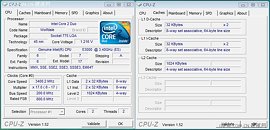- Joined
- Oct 9, 2007
- Messages
- 47,670 (7.43/day)
- Location
- Dublin, Ireland
| System Name | RBMK-1000 |
|---|---|
| Processor | AMD Ryzen 7 5700G |
| Motherboard | Gigabyte B550 AORUS Elite V2 |
| Cooling | DeepCool Gammax L240 V2 |
| Memory | 2x 16GB DDR4-3200 |
| Video Card(s) | Galax RTX 4070 Ti EX |
| Storage | Samsung 990 1TB |
| Display(s) | BenQ 1440p 60 Hz 27-inch |
| Case | Corsair Carbide 100R |
| Audio Device(s) | ASUS SupremeFX S1220A |
| Power Supply | Cooler Master MWE Gold 650W |
| Mouse | ASUS ROG Strix Impact |
| Keyboard | Gamdias Hermes E2 |
| Software | Windows 11 Pro |
Although a large chunk of products based on the new sockets LGA-1156 and LGA-1366 arrive in 2010, effectively pushing LGA-775 out of the extreme, performance, and upper mainstream segments, Intel will continue launching new low-end LGA-775 processors in an effort to digest inventories of motherboards and memory compatible to that socket. The company's grassroot processor brand Celeron will be updated with the E3000 series, consisting of dual-core processors based on the Wolfdale-1M core. The 45 nm based core offers the essential features for basic computing, while running cool and priced low.
Two quarters ahead of its expected launch, sources in the Chinese media unearthed Celeron E3900, perhaps the last SKU in the E3000 series. Slated for Q1 2010, the Celeron E3900 runs at 3.40 GHz (200 MHz x 17), with an FSB speed of 800 MHz. It has a shared L2 cache size of 1 MB, and supports the most common instruction sets including SSE3, SSSE3, and x86-64, although SSE4.1 and Intel-VT isn't part of it. The latest company roadmap of the essential and value segments show that the company looks as far as Q3 2010 with its Celeron and Core 2 Duo brand products, with existing number schemes. In essence, retailers in Q3 2010 shouldn't have stock problems selling you these processors.

View at TechPowerUp Main Site
Two quarters ahead of its expected launch, sources in the Chinese media unearthed Celeron E3900, perhaps the last SKU in the E3000 series. Slated for Q1 2010, the Celeron E3900 runs at 3.40 GHz (200 MHz x 17), with an FSB speed of 800 MHz. It has a shared L2 cache size of 1 MB, and supports the most common instruction sets including SSE3, SSSE3, and x86-64, although SSE4.1 and Intel-VT isn't part of it. The latest company roadmap of the essential and value segments show that the company looks as far as Q3 2010 with its Celeron and Core 2 Duo brand products, with existing number schemes. In essence, retailers in Q3 2010 shouldn't have stock problems selling you these processors.

View at TechPowerUp Main Site







